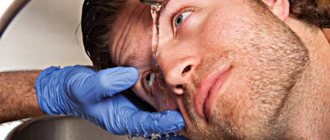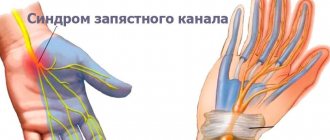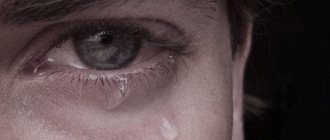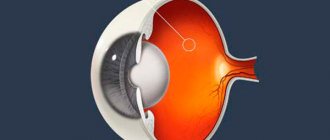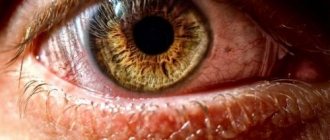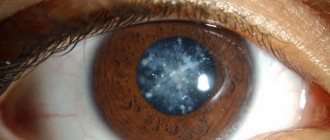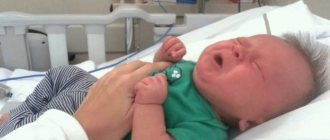One of the most common diagnoses that children leave the ophthalmologist's office with is amblyopia. Up to 3% of children under the age of 8 face this problem. Find out more about lazy eye syndrome and how to deal with the disease from our article.
Amblyopia - (from the ancient Greek words amblyos - “blind” and opia - “eye”, “vision”) - a visual impairment associated with the pathological work of one, or less often, two eyes at once. In the classic course of the disease, one eye of the patient sees much worse than the other, or does not see at all, as a result of which the transmission and perception by the brain of the image entering the retina is disrupted.
Signals coming from an eye that has not “learned” to see well begin to be ignored by the brain over time. An increased load is placed on the second, more “skilled” eye: this leads to an even greater weakening of the functions of the “lazy” eye, often despite its complete physical well-being.
Vision in amblyopic eyes
The result of the disease is a decrease in visual acuity - functional and most often reversible, but requiring careful correction.
Types of amblyopia
Depending on the period of occurrence, the disease can be congenital, or primary, and acquired, or secondary.
According to the etiology of occurrence, acquired amblyopia can be:
- dysbinocular;
- deprivation;
- refractive;
- hysterical;
- anisometropic;
- mixed.
In most cases, the mechanisms of the disease, even with different origins, are similar. They are caused by visual deprivation or abnormal binocular connections. These phenomena cause dysfunction of central vision.
Dysbinocular amblyopia is associated with impaired vision in both eyes, which occurs due to prolonged suppression of the eye.
Among this type of pathology, there are 2 more subtypes:
- amblyopia with correct fixation. In this case, the anchoring zone is the retinal macula;
- amblyopia with incorrect fixation. The anchoring zone is any other part of the retina. This type of disease is found in 75% of all patients with amblyopia. The exact subtype of the disease is very important, because this determines the type of treatment.
In deprivation amblyopia, disorders are associated with a congenital or acquired early in life decrease in the transparency of one or more optical structures of the organ of vision.
Such amblyopia is detected when vision decreases, which persists even as the cause of the disease is eliminated. This is often observed after cataract extraction.
Refractive amblyopia develops against the background of failures of the refractive system without its correction. The mechanism of development of the disease is associated with a long continuous flow of a blurry image onto the retina of the eye.
Anisometropic amblyopia appears due to different refractions of the eyes, in which the size of the image of objects in the visual organs varies greatly. The patient cannot form a single visual image.
Sometimes hysterical amblyopia occurs. This disease occurs against the background of psychosomatic disorders, severe stress, depression, etc. Vision may be slightly or severely impaired.
Amblyopia is also classified according to the degree of vision loss. Weak amblyopia is observed with vision of 0.4-0.8 units, average - with vision of 0.2-0.3 units. With a high degree of amblyopia, vision is reduced to 0.1 units or lower.
Amblyopia degrees
Ophthalmologists determine the degree of the disease depending on the patient’s visual acuity:
- Very weak degree, visual acuity can be up to 0.8-0.9 diopters.
- Weak degree (visual acuity is 0.5−0.7 diopters).
- Moderate amblyopia (visual acuity - 0.3−0.4 diopters).
- High degree of amblyopia (visual acuity - 0.05−0.2 diopters).
- A very high degree of amblyopia, when vision reaches only 0.04 diopters.
Amblyopia of the 1st degree can be asymptomatic. With grade 2 amblyopia, the patient or his parents notice the first signs of the disease. They intensify when amblyopia reaches degree 3 or higher. The greater the degree of amblyopia, the more difficult it is to cure.
Causes of amblyopia
Amblyopia can be caused by various etiological factors. The cause of dysbinocular amblyopia is monolateral strabismus, in which the affected eye does not participate in the visual process.
Therefore, amblyopia develops in the eye where strabismus is observed.
To prevent double objects from occurring, the brain suppresses the image from the retina of a squinting eye. Nerve impulses from it stop flowing to the brain, that is, the eye gradually atrophies, as a result of which signs of amblyopia appear in it. In turn, due to amblyopia, strabismus continues to progress.
Deprivation amblyopia
Deprivation amblyopia is caused by leukoma - the formation of a cataract on the cornea, or clouding of the lens, ptosis of the upper eyelid, damage and scarring of the cornea, organic disorders of the vitreous body, hemorrhages in the structures of the eye.
Anisometropic amblyopia
The cause of anisometropic amblyopia is high degree anisometropia that cannot be corrected. In the organ of vision where refraction is more impaired, signs of amblyopia appear. Anisometropia is associated with myopia of more than 8 diopters, farsightedness (from 5 diopters), and moderate astigmatism and higher.
Refractive amblyopia
Refractive amblyopia is also caused by uncorrectable farsightedness, astigmatism, and myopia. Thus, myopic amblyopia can develop with myopia from 2 diopters, astigmatic - from 1.5 diopters, hypermetropic - from 0.5 diopters.
Hysterical amblyopia
Hysterical amblyopia may be associated with exposure to pathogenic mental factors that are caused by nervous disorders and hysteria. In this case, amblyopia can also be bilateral. Patients have impaired color vision, increased photosensitivity, narrowed fields of view, etc.
Congenital amblyopia
Congenital amblyopia most often occurs in children born prematurely, with a burdened history of intrauterine development, with deviations in mental development, and also in those who have parents with amblyopia or strabismus. Amblyopia is a frequent companion to various genomic pathologies.
Treatment options
The best results for lazy eye therapy in a child are observed if he is in the age range of 3 years - 6 years. The older the baby, the longer and more complex the therapy. From the age of 12, the disease cannot be corrected.
Amblyopia therapy requires enormous patience and consistency. All prescribed techniques must be carried out regularly. Not a single day should be missed to ensure recovery. For example, you should not attend camp for children and take breaks.
If left untreated, the vision in the defective eye gradually declines, and over time the child will become blind in one eye.
Treatment methods for amblyopia in children are aimed at normalizing binocular vision. For this purpose, conservative, hardware, and surgical methods are used. The primary task of a specialist is to identify and eliminate the cause that led to the disease. At the same time, treatment of strabismus, if any, is carried out.
Optical correction
It is the first stage of therapy and the main one for the refractive form. If a high degree of pathology of 3–5 degrees is diagnosed, then the glasses must have high quality lenses.
Optical correction allows you to achieve good visual acuity in both eyes and protects them from injury.
An alternative to glasses are contact lenses. However, they need to be constantly looked after. The lenses do not limit the field of view and allow you to play sports.
Occlusion
The method involves wearing a special bandage (occlusion):
- on a healthy eye. In this case, the brain receives signals from the defective eye and begins to actively cooperate with it;
- lazy eye patch. This method is used for amblyopia with improper fixation of vision;
- wearing a bandage on both eyes alternately.
The greatest effect of occlusion therapy is observed in children under 6 years of age. However, it can lead to undesirable consequences, including:
- visibility in the healthy eye decreases if you neglect regular visits to a specialist;
- double vision;
- rashes on the skin at the site of occlusion;
- worsening of the course of strabismus.
Penalization
An alternative to occlusion. The method involves instilling special drops into the eyes, causing dilation of the pupils and degrading image quality. This forces the defective eye to be more active.
Penalization glasses are also used. They limit the visibility of the healthy eye in children, and the lazy one becomes the main one. The choice of lenses for glasses is carried out individually.
The penalization method is most effective under the age of 4 years.
Drug treatment
The modern method of treating amblyopia is medication. Tenon's space is catheterized and solutions are administered according to a specific scheme. Medication therapy is supplemented with light and laser stimulation, and video auto-training.
For children under 7 years of age, catheterization is performed under general anesthesia or mask anesthesia; for older children, local anesthesia is provided. The free end of the catheter is fixed in the infraorbital region with a plaster. The drug is administered with a sterile syringe.
Drugs are administered:
- Cerebrolysin – stimulates intracellular protein production.
- Agapurin, Dicynon - improve the rheological properties of blood and its microcirculation.
- Emoxipin – protects the retina from the negative effects of light.
- Taufon – promotes tissue regeneration.
Pleoptics
Devices are used to treat amblyopia in children, aimed at activating the lazy eye with various stimuli: electrical impulses, heat, light. How to treat amblyopia in children? Procedures applied:
- Synoptophore or Amblyocor apparatus;
- devices Reamed, BOK-1 (binocular optometric complex);
- light, laser, photostimulation;
- acupuncture;
- vibration massage.
Hardware treatment also includes a set of exercises on the computer and educational games. Programs for the treatment of amblyopia (Flower, Web, Crosses program) are freely available on the Internet. There are video exercises on the Internet for the treatment of amblyopia. They help improve the concentration of the lazy eye. All you need to do is follow the movements of objects on the screen.
Pleometry is resorted to only after the etiological factor has been identified and eliminated.
Operation
It is used in situations where the disease is caused by cataracts, nystagmus, astigmatism, and drooping eyelids. Modern ophthalmology performs operations with high precision and allows you to restore visual acuity.
If strabismus in children is congenital, it is recommended to undergo surgery before the age of 6 months. In mild stages of the pathology, you can wait to intervene until the baby is older.
Laser vision correction in children with amblyopia is not used due to age-related contraindications.
Exercises
Treatment of amblyopia in children at home is supplemented with special gymnastics, in which the seeing eye is covered with a bandage. The ophthalmologist selects the exercises individually.
Examples:
- A circle of dark paper with a diameter of 5–7 mm is glued onto the light bulb. The patient looks at the switched-on lamp and focuses on the circle for 30 seconds, then sharply turns his gaze to a blank sheet of paper;
- The child is shown the text at a distance, holding the printout up to his face until the picture begins to blur. Then smoothly pull the sheet back.
Clinical picture of amblyopia
Because there are several types of the disease, they have different symptoms and signs. If amblyopia is mild, it may be asymptomatic.
In young children, all manifestations of the disease are assessed only by the parents. Even at an older age, a child is not able to accurately describe all the unpleasant sensations, as well as whether both eyes are involved in the visual act, or just one.
If your child has strabismus or nystagmus, you should consult a doctor about possible amblyopia.
It is also possible to suspect pathology if there are difficulties with fixating the gaze on a colored object.
In schoolchildren, the development of amblyopia is often indicated by a decrease in vision, as well as the absence of any positive dynamics against the background of correction.
Signs of amblyopia may include:
- frequent closing of one eye;
- impaired orientation by a child in an unusual environment;
- tilting the head when looking at a directly located object;
- impairment of twilight and color vision.
With hysterical amblyopia, adults complain of a sharp decrease in vision, which occurs a short period of time after hysteria or a nervous breakdown.
Amblyopia may be temporary and resolves after a few days or months. In general, vision loss with any type of amblyopia can be slight or very pronounced, leading to blindness.
Clinical manifestations of the disease
The main symptom of amblyopia is blurred vision in one eye. The brain receives different pictures from the organs of vision, and is not able to form a holistic image from them.
It is difficult to detect the disease in children. When a child is still small, he is not able to complain about his health. Children of older preschool age with strabismus and amblyopia may not realize what is happening.
Symptoms of amblyopia vary depending on the type and severity of the pathology. Thus, the refractive form can occur without any manifestations at all. Usually the disease is detected in children undergoing a medical examination before entering school.
General characteristics of children with amblyopia and strabismus:
- vision deteriorates;
- photosensitivity increases;
- spatial orientation is disrupted;
- the baby has difficulty distinguishing colors;
- Difficulties arise in determining the distance and shape of objects.
Diagnosis of amblyopia
To detect amblyopia, you should consult an ophthalmologist for a thorough, comprehensive examination. The examination includes assessment of the shape and size of the eyelids, the position of the eye and palpebral fissure, and the reaction of the pupils to light. Next, the doctor performs a standard vision test with and without correction, conducts color testing, refraction testing, and perimetry. During these procedures, amblyopia and its degree are diagnosed.
To exclude pathologies of the inner part of the eye, biomicroscopy, ophthalmoscopy, examination of the fundus, and measurement of intraocular pressure are performed. The eyes are examined in transient light to determine the degree of transparency of the lens and cornea. If their opacity is detected, an ultrasound of the eye will be required.
In case of strabismus, its angle is calculated (according to Hirschberg, and also using the synaptophore device). Diagnosis of anisometropic, refractive amblyopia is based on the use of skiascopy and refractometry data. The complex of examinations is complemented by electroretinography and a visit to a neurologist.
Why does amblyopia occur?
This is an eye pathology of a fairly common form. It can form on both the left and right eyes. In this case, the loss of visibility can be either complete or partial. Since no anatomical abnormalities occur in the eye, the disease can be successfully treated if therapy is started in a timely manner. But if corrective therapy is not started on time, vision loss may occur.
What is amblyopia
The development of the disease in adults generally begins asymptomatically and gradually. But after some time, the following sensations may appear.
- Occasionally sees double.
- Glasses do not help correct vision.
- One eye begins to squint.
- The eyes get tired faster than before, even with small amounts of stress on them.
- An eye that loses its functionality closes when used.
- Spatial orientation is impaired.
- Peripheral vision decreases.
- Central vision may decrease due to stress.
Signs of amblyopia
Important! If these symptoms are observed, it is necessary to consult a doctor without delay, since the longer amblyopia is left untreated, the less chance there will be of recovery and return to previous vision.
Amblyopia (lazy eye)
The causes of the disease are the following:
- eye injuries with muscle destruction;
- farsightedness in a progressive form;
- disorders related to neurology;
- mental disorders;
- defective changes in the cornea;
- genetic predisposition.
Amblyopia or, as it is called in ophthalmology, “lazy eye”, is quite common - it affects every 100 people in the world, mostly children
Types of disease
Various types of this disease occur in children and adults. Each exhibits its own characteristics and demonstrates varying degrees of curability.
Types of "lazy eye"
Table. Adult amblyopia – types.
| Variety | Characteristics |
| Dysbinocular | The development occurs as a result of already existing strabismus, namely in the squinting eye - it ceases to function. This is in most cases, but with a small percentage of patients the opposite happens - the eye goes out of function due to the progress of amblyopia, then strabismus develops on it. |
| Anisimetropic | With this form, the refractive power of the pupil goes far beyond normal limits and can reach three diopters or more. |
| Refractive | As the name suggests, this type occurs due to the lack of treatment for refractive errors. If corrective optics are not worn or worn irregularly, refractive amblyopia may occur if you have existing astigmatism or farsightedness/myopia. |
| Strabismatic | Characterized by fixation of gaze on the retina. It is divided into a central view, when fixation occurs in the center of the retina, and a non-central view - the gaze is fixed on any peripheral area. |
| Deprivation | This type is also called obscurational amblyopia. It is considered a fairly common disease. Occurs if there are scars or other pathologies in the eye that make focusing difficult, with cataracts or with a cataract. If the field of vision is blocked due to drooping eyelid, this can also be complicated by deprivation amblyopia. |
| Hysterical | Develops due to stress, nervous shock, breakdowns and other psychoneurological situations. It is considered the only type, after treatment of which vision can be completely restored. With all other varieties, it is still partially lost during the treatment process. |
Amblyopia functional and hysterical
Amblyopia has five degrees, which are classified according to the preservation or degree of vision loss.
- Visual acuity 0.9 units - first.
- Vision 0.5 units - second.
- Sharpness 0.3 – third.
- An indicator from 0.2 to 0.05 is the fourth.
- Vision below 0.05 – fifth.
Changes in vision with amblyopia
Treatment of amblyopia
For amblyopia, the results of therapy directly depend on the time the patient goes to the doctor and the adequacy of the prescribed course. Before the age of 7, correction of amblyopia is quite successful, while after 10-12 years the disease is very difficult to correct.
First of all, it is necessary to find the cause of amblyopia and eliminate it. For example, if deprivation amblyopia is detected, it is necessary to eliminate cataracts, or correct the ptotic eyelid using surgical methods, perform intensive resorption therapy for hemorrhage in the vitreous, or excision it. For dysbinocular amblyopia, surgical correction of strabismus is recommended.
If a patient is diagnosed with refractive or anisometropic amblyopia, then therapy includes mainly non-surgical methods. Visual acuity must be corrected using contact lenses, glasses, and special night lenses.
Next, if possible, laser correction of the disease is performed. Then, after 19-21 days, a course of pleoptic treatment is used. Its purpose is to provide equal roles for both eyes, that is, to activate the affected organ of vision. For this purpose, passive and active pleoptics are used.
Passive pleoptics is the sealing of the functional eye, or occlusion. At the same time, the retina of the diseased eye is stimulated using electrical impulses, light rays, and various computer simulators.
Methods such as laser, vibration and magnetic stimulation, and acupuncture provide a good effect for amblyopia. Treatment should be repeated up to 4 times a year.
In preschool children, amblyopia therapy is performed using a special method - penalization. It consists of a special deterioration in the visual function of the active eye through hypercorrection or local application of atropine.
When vision in the dominant organ of vision decreases, in the amblyopic eye, on the contrary, it improves. Physiotherapy for amblyopia, including electrophoresis with drugs, also gives good results.
Upon completion of the first therapeutic stage, restorative treatment for the second eye, or orthoptic therapy, is prescribed. This stage should replace the previous one as soon as the child’s visual acuity is at least 0.4 units. In this case, his age must be at least 4 years.
A synoptophore apparatus is used: looking through the eyepieces, the patient visualizes several parts of the picture and compares them into a single whole.
Once approximately equal vision is achieved in both eyes, treatment is stopped. In the treatment of hysterical amblyopia, psychotropic and sedatives are used, as well as psychological consultations.
Reasons for development
It is important for parents to identify the disease in the early stages. In this case, it is reversible and, with favorable factors, vision can be completely restored.
In childhood, amblyopia often develops against the background of other eye diseases that interfere with the formation of binocular vision. The most common factors are:
- myopia and hypermetropia in children;
- strabismus (strabismus);
- prematurity and low birth weight;
- developmental delays;
- genetics (cases of amblyopia or strabismus in parents and relatives);
- A woman’s poor lifestyle during gestation can lead to dysfunction of visual perception in children.
Among the organic causes in children are:
- drooping eyelid (ptosis);
- clouding of the lens (cataract);
- penetration of blood into the vitreous body (hemophthalmos);
- corneal degeneration.
Prognosis and prevention
The prognosis is directly related to the period of seeking help. If correction of pathology is started in a timely manner, the results are more effective. If therapy is carried out before the age of 7, then its results are, as a rule, very high, and vision is completely restored.
In adults, vision loss is, unfortunately, irreversible.
To prevent amblyopia, you should be regularly examined by an ophthalmologist, in children - from 1 month. It is also necessary to eliminate defects such as ptosis, cataracts, strabismus, etc. in a timely manner.
Prevention
In order to prevent strabismus and amblyopia, it is necessary to undergo regular ophthalmological examinations and immediately show the child to a doctor at the first vision complaints. This will help prevent severe eye pathologies.
The time spent watching TV and sitting at the computer is strictly limited. A balanced diet and rest regime strengthens the immune system, which reduces the risk of developing amblyopia. While reading, the room is well lit; the child should not hold the book too close to his eyes.
Dr. Komarovsky does not recommend treatment with folk remedies, as this will not lead to positive dynamics, but will only worsen the course of the disease.
Severe lazy eye syndrome in children increases the risk of blindness because the strain on one eye increases significantly. The task of parents is to react in time and take appropriate therapeutic measures so that high visual acuity is maintained. With the right approach, treatment takes 3–4 months.
Kinds
Depending on the cause, ophthalmologists distinguish several types of amblyopia of the eye. They need to be distinguished in order to understand the mechanism of development of the disease and determine treatment tactics.
Types of pathology:
- Dysbinocular amblyopia. Develops in children with strabismus. Since the squinting eye always looks to the side, the child’s binocular vision is impaired and double vision appears. To eliminate visual discomfort, the brain begins to selectively suppress visual impulses. Over time, the eye begins to lose functional activity.
- Anisometropic (refractive amblyopia). Occurs when there is a large difference in the refraction of the two eyes (3 or more diopters). The cause may be asymmetrical myopia, astigmatism or farsightedness, expressed to varying degrees. The mechanism of development of pathology is similar to the previous version.
- Psychogenic. Both eyes in this case are completely healthy and fully functioning. Lazy eye syndrome develops due to neurological or neuropsychiatric disorders.
- Obscurational amblyopia. It occurs due to clouding of the optical media of the eyeball, which prevents the passage of light rays. Due to long periods of inactivity, the eye loses its ability to see. Cataracts, corneal cataracts, and destruction of the vitreous body can lead to the development of obscurational amblyopia.
Development mechanism
“Blindness” can result from any defect in the visual system that interferes with the conjugate focusing of the eyes. Whatever the type of disorder - strabismus, cataracts, anisometropia - it leads to the impossibility of combining visual signals from both eyes into a single image. The brain cannot perceive information clearly and, to simplify the image, begins to ignore one of the sources. This is a simplified concept of the cause of amblyopia.
Congenital amblyopia can be genetically determined and is part of some hereditary pathologies: Benche's syndrome, expressed in strabismus and asymmetrical hyperplasia of the face, Kaufman's syndrome, which has oculo-cerebro-fascial manifestations.
Among acquired extraocular causes of blindness, toxic amblyopia occupies a special place. It develops due to damage to the optic nerve in its orbital part by a toxic substance (lead, methanol, chloramphenicol, digoxin, ethambutol, methanol) or the lack of adequate nutrition to the nerve fibers. Deficiencies of vitamins B1, B12, folic acid, proteins and antioxidants are usually determined. Deterioration of vision occurs painlessly, the process occurs symmetrically in both eyes.
Amblyopia in children
Modern education provides that when a child enters first grade, he can already read. Parents begin a kind of brainstorming as early as 4 years old - after all, they don’t want to go to a “regular” school and fall on their faces in front of their friends.
But they do not know that the child’s eye is still immature and early reading can lead to stretching of its outer shell, and this is a step towards myopia or amblyopia. If this problem appears, parents often are not aware of it, but consider the child clumsy.
The fact that a child lives in a “vague” world can only be revealed at an appointment with an ophthalmologist - not the most popular doctor among parents. Therefore, it won’t hurt to go to his office once a year. In the first grade, the child’s eyes are even more stressed - daily lessons, homework.
And after classes I really want to play on the computer or watch TV. You may have to pay for the stress by deteriorating your vision. This could be myopia, so-called accommodation spasm, or amblyopia.
Perhaps amblyopia is the most dangerous of the above-mentioned ailments. After all, if left untreated, it can lead to vision loss. Take a closer look at your baby. If your child closes one eye while reading or watching TV, or turns his head to the side when looking at an object in front of him, he may have lazy eye or amblyopia.
In this problem, one eye sees less clearly than the other, and the brain is unable to correctly compare the two images. This can lead to loss of vision, first in the weak eye, and then in the strong one. You've probably seen kids with a patch stuck on their glasses over one eye - this is how this disease is treated.
Here is an easy way to test your vision at home and determine if your child has amblyopia:
- Cover one of your child's eyes (you may need a helper). Hold an object in front of him (for example, a teddy bear for a toddler or a picture for an older child).
- See if your child follows the object with the uncovered eye as you move it from side to side and up and down. You can ask your older child to tell you what the picture is or ask for details. Then close the other eye and see if the child follows the object just as well and just as far.
Testing your baby's vision is much more difficult, as he may lose interest or become distracted before your test is over. But if one eye seems weaker, try testing it again another time—perhaps starting with the other eye.
If your child consistently confirms that he can see better in one eye than the other, make an appointment with an ophthalmologist to diagnose and treat the problem. We also advise you not to ignore examinations by specialists when registering your child for kindergarten or school.
Tips for parents
- To maintain good vision of the baby, parents must take care of the child’s fragile nervous system. And for this you need: a daily routine, good nutrition, physical education.
- All black berries, fish oil, liver, as well as carrot juice with olive oil are good for the eyes - they are rich in vitamin A, which improves vision and relieves eye fatigue.
- A child's eyes need rest. When your child is doing homework, make sure he has a break every 20 minutes. Let him do eye gymnastics at this time: stand near the window, focus on the point drawn on it and count to 10. Repeat the same with a distant object on the street.
- If your child has poor eyesight, be sure to notify the teacher about this and ask to be seated at the first desk.
- Limit watching TV and sitting in front of a monitor at home: computer games strain the eyesight, so if a child was doing his homework and then immediately moved to his “best friend,” problems with the eyes will not be long in coming.
- Carefully monitor the distance between the child’s eyes and the working surface: it should be 30-35 cm. This distance provides the best conditions for visual work.
- There must be a lamp on the left side of the student’s desk, in addition to the main lighting. But lamps with fluorescent lighting can only be used from the age of 12 - they are very tiring for the eyes, so it is better to use ordinary lamp ones.
Prevention of amblyopia
To minimize the development of amblyopia in one or both eyes at once, it is recommended to remember and follow simple prevention rules every day.
They consist of the following actions:
- undergo a timely examination by an ophthalmologist after detecting the first signs of decreased visual acuity;
- stop using alcoholic beverages, tobacco products and drugs;
- avoid injury to the eyeball;
- When performing plumbing and repair work, use personal protective equipment, covering your eyes with glasses with shockproof organic glass;
- do not engage in power sports that involve hitting the face;
- take therapeutic and surgical methods to eliminate strabismus (regardless of the cause of its development);
- saturate your diet with foods whose vitamins and minerals improve visual acuity (blueberries, boiled chicken eggs, carrots, pumpkin, apricot, mango);
- prevent the development of chronic infections of the eyeball, which cause sluggish inflammation of its mucous membrane;
- If an ophthalmologist prescribes wearing an occlusion on the eye, do not ignore this doctor’s recommendation.
Compliance with the above rules for the prevention of amblyopia makes it possible not only to avoid the occurrence of this pathology, but also minimizes the development of other types of ophthalmological diseases. This is important to remember for men and women who have a genetic predisposition to diseases of the organ of vision.
What is amblyopia of the eye
Amblyopia is a visual impairment not associated with organic eye pathologies, which is functional in nature. Due to changes in the physiological state of the visual sensory system, a pathology occurs that cannot be corrected with lenses. The disease is called “lazy eye” due to inactivity and lack of involvement of the visual analyzer in the work.
Amblyopia occurs against the background of a deviation from normal fixation, that is, foveal fixation associated with the central macula. In a state of amblyopia, the image of objects is fixed:
- parafoveal – offset from the center by 2.5˚;
- macular - on the periphery of the macula;
- in the peridiscal zone - behind the central region of the retina.
Amblyopia code according to ICD-10:
- H53.0 - amblyopia due to anopsia (decreased vision caused by neurological disorders);
- H54 - blindness and reduced vision.
Amblyopia symptoms
Clinical manifestations vary from patient to patient and depend on their age, duration and severity of the pathology. Among them are:
- deterioration of visual function;
- lack of effect from optical correction;
- deterioration of orientation in space, in unfamiliar places;
- covering one eye or tilting the head to the side when focusing on a specific subject;
- violation of color perception;
- decreased dim vision;
- blurry picture;
- strabismus.
Tips for at-home lazy eye workouts
It is advisable to complement occlusion therapy with the following exercises for amblyopia, which are technically called “pleoptic training”. They are carried out in specialized orthoptic clinics using the necessary devices.
It is also important to do additional exercises at home. It is not enough to simply cover the healthy eye; it is important to try to make the amblyopic eye work. Exercises for children and adults are practically no different.
The main difference is that adults must devote more time to exercise. Suitable activities for training a healthy eye:
- assembling mosaics, puzzles;
- modeling from plasticine or clay, wood carving;
- coloring books - you should start with larger and simpler pictures, gradually moving towards smaller and more complex images;
- outlining - through transparent paper with a colored pencil along a pre-drawn line with a brush or watercolor;
- pinning image templates;
- exercises on the line - on a pre-drawn line, a person traces circles, squares or other more complex shapes, trying to trace exactly along the line, in addition, you can stick to pre-cut shapes from colored paper;
- stringing beads;
- cutting and folding models - various patterns and details are cut out (from thick paper, fabric, felt, etc.) and attached or glued to each other, you can make houses, flowers, cars, etc., you can also cut a picture into several parts, and then assemble it into the original image;
- fixation on dots - draw several dots on paper, which you will later connect into drawings, such as flowers in a vase;
- embroidery - you can embroider on paper or fabric with colored threads, this exercise is very effective because it forces you to concentrate;
- games - checkers, cards, chess, dominoes, etc.;
- movement - ball games, table tennis, line walking;
- reading - you should start with text in large font, moving to smaller ones;
- computer games, watching TV (for a limited time).
The more the acuity of the amblyopic eye increases, the more subtle the activities and games that are included in the training should be. The more visually intense activities a person engages in, the faster their amblyopia will improve.
Symptoms
Most people, especially those with mild amblyopia, do not realize they have this disease. The only exception to this rule is patients with severe strabismus. It is quite easy to notice their lack of binocular vision.
It is impossible to determine the initial stages of amblyopia on your own. Most often, a patient absolutely by accident, during a routine examination by an ophthalmologist, learns that his eyes have different optical powers.
The first manifestation of the disease is a person’s difficulty in orienting himself in an unusual or unfamiliar place. With amblyopia, patients often have impaired coordination of movements, which is why they are perceived by others as sloppy or clumsy. Another symptom of amblyopia is the patient closing one eye when watching television or reading. Children suffering from amblyopia tilt or turn their heads when looking at an object that interests them.
In addition, with amblyopia, patients experience rapid fatigue when performing work that requires high visual load (working with documents, embroidery, knitting, drawing, etc.). They often complain of frequent and persistent headaches.
Nature of the pathology
The pathology is characterized by a violation of the refractive power (refraction) of the eye, distortion of the contour of objects when studying it. Amblyopia literally means lazy or blind, which is why clinicians often call this condition “lazy eye.” Patients cannot focus their vision, the contours of the object are blurred, and are shifted to the right or left. Typically, pathology occurs if the patient has various ametropia (when the image of objects at a distance is focused in front of or behind the retina). There are two main forms of refractive amblyopia:
- primary process, when the disease develops in the fetus during the perinatal period due to abnormal formation of the eyeball;
- a secondary process when pathology is formed as a result of constant exposure to certain factors on the human visual system.
Light rays irritate the retina of the eye, contributing to the normal functioning of the visual system and its development. The main importance is given to the frontal region of the retina. With its normal function, a person’s central vision is clear, concentrated on a distant object. The retina develops immediately after the baby is born and exposed to daylight. The rays enter the visual center located in the brain, triggering the processing of the received information. If central vision decreases, which cannot be adequately corrected optically (glasses, contact lenses), then the development of amblyopia can be suspected.
Important! The main feature of the disease is the absence of characteristic changes in the fundus of the eye. Against the background of refractive amblyopia, the development of the nervous system in children slows down due to distortion of information received by the brain about distant objects and actions.
Diagnostics
Diagnosis should be carried out by an ophthalmologist. Eye acuity is checked using special tables. In the presence of strabismus, the angle of deviation from the norm is determined by the Hirshberg method.
To identify amblyopia, you need to be examined by an ophthalmologist. After conducting tests for eye acuity, color correction, perimetry and refraction, the doctor will determine the severity of the disease.
During a comprehensive study, additional examinations will be carried out: ultrasound of the eyeball, refractometry, skiascopy, and a consultation with a neurologist will be scheduled.
There are five known degrees of amblyopia. The decline in eye acuity occurs progressively from low to high.
Preventive measures to prevent amblyopia in adults
Unfortunately, the disease can only be completely cured in childhood. It is best to begin treatment for amblyopia at the age of under six years, until the formation of the visual organ is completed. If amblyopia makes itself felt only in adulthood, then the pathology can be cured with surgery. After this, an additional treatment method is prescribed.
But every patient can prevent himself from developing an eye disease. It is enough to follow a few simple recommendations.
- Provide the body with the necessary vitamins. To do this, you need to consume foods that contain many microelements, and during the season of vitamin deficiency, add vitamin complexes.
- Do not strain the visual organ and allow it to relax more often. To do this, you can do simple exercises every day.
- If an eye disease was discovered in childhood, then you should not delay treatment. The sooner it is started, the less consequences there will be.
- Do not strain children's eyes. During the day, the child should watch TV or play on the computer for no more than thirty minutes a day.
- If there is nearsightedness or farsightedness, then it is necessary to correct vision by wearing lenses and glasses.
- Don't forget about preventive examinations. For children under two years of age, they are performed as often as possible, after which the patient must visit doctors at least once a year. When the first symptoms appear, you should immediately seek help from a doctor.
Treatment tactics
The OkoDent clinic offers its clients a whole range of options to treat pathological vision loss. The main advantages include high quality equipment, professionalism of employees, and an individual approach to each client. The treatment process begins with conservative treatment, namely the selection of optical correction (glasses or contact lenses). A month after wearing corrective products, the doctor prescribes pleoptic procedures that stimulate the functional ability of the weak eye (one or both). There are two main methods of pleoptics:
- passive, when the activity of a healthy eye is artificially reduced by applying a dark bandage);
- active when there is an additional stimulating effect on the affected eye by computer programs.
Additionally, eye drops are prescribed to reduce visual acuity of the functionally dominant eye. Atropine is used for this. The final stage of therapy is the restoration of binocular vision through orthoptic treatment. A special feature of the method is the solution of visual problems of combining double images into one object. Additionally, vibration massage, electrophoresis, reflexology and other physiotherapeutic methods are performed to enhance the therapeutic effect.
Forecast
The outcome of the disease is related to the time of diagnosis and the cause that led to pathological changes. Conservative treatment can restore full function before the age of seven, as the child's eyes are still developing during this period.
Children diagnosed with amblyopia with a high degree of visual impairment should attend preschool institutions that specialize in visual correction. Additional activities and staff attention create comfortable conditions for a sick child and prevent emotional disorders.
The result of treatment depends on:
- full compliance with medical orders;
- literacy of ocular fixation;
- patient's age and initial visual capabilities;
- applied methods.
How to treat amblyopia
When amblyopia of all types, except hysterical, is detected, an ophthalmologist provides therapeutic treatment. The latter type requires the intervention of a psychotherapist.
By the way. The deprivation type can only be treated surgically, and the sooner it is carried out, the greater the chance of a successful result.
Treatment of amblyopia
Treatment must be carried out in a complex manner.
- If strabismus is present, it is eliminated in parallel with the treatment of concomitant or resulting amblyopia.
- In case of refractive errors, they are corrected by wearing special optics and regularly performing eye exercises.
- The strabismus type can be treated therapeutically and using the hardware method.
- Deprivation requires surgical intervention in most cases.
- The hysterical appearance involves the use of sedatives in combination with therapeutic methods.
Performing eye surgery to correct amblyopia
Occlusal method
This treatment method helps get rid of the disease or significantly reduce its progress in seven out of ten cases. Its essence is as follows. A patient diagnosed with any type of amblyopia, other than hysterical, wears a special type of corrective glasses. A non-transparent lens is placed on the undamaged eye to block vision. And on the diseased eye there is ordinary glass. The point is that the brain, not receiving visual information from a healthy visual organ, causes the sick one to become more active. Through the daily effort of capturing images and transmitting them to the brain, the amblyopic eye begins to focus and see better and better. Both glasses and lenses can be used as optics, one of which has an opaque base. Wearing for two hours.
One eye is blocked
By the way. It is quite possible to use a regular black bandage instead of glasses or lenses, which will cover the healthy eye. But this method is not considered aesthetic, so it is not used in our time.
It is worth noting that occlusion is most applicable for childhood amblyopia. It is also used for adult patients, but correction does not always occur within the expected time frame and at the proper level. Therefore, if three months after starting to use the method there are no results, move on to another treatment method.
Special glasses are used for correction
Hardware method
In this case, the device helps to carry out the correction. During the corrective procedure, the patient undergoes video-computer auto-training. The pathological eye is stimulated by blinding stimulation of the retinal layer and a change in successive images. This technique is already more than half a century old, and the devices that have been used to implement it have not changed it much. During treatment, the following procedures are performed:
- exploitation of granular fields;
- stimulation of the visual pathways using electricity;
- the use of flash lamps to influence the retina.
The operation of the device is based on the video-computer auto-training method.
Also, at the ongoing stage of hardware treatment, physiotherapeutic procedures are used, which are necessarily included in the complex. They are needed to increase blood circulation in the vascular connections of the eye.
In the process of complex exposure, metabolic processes are activated, the optic nerve is stimulated, restoring its functions, and conduction functions are activated.
Amblyocor
Important! The hardware method in most episodes of patient treatment helps to restore, if not completely vision, then its binocular capabilities of the eye and its accommodative properties.
Eye gymnastics
It should be noted that eye gymnastics is not a therapeutic method in its pure form, but is used as a maintenance therapy that enhances the main one. But in a number of cases, when the disease is detected at the very initial stage, it is possible to achieve a restorative result only by using ophthalmological gymnastics. Processes in the eyeball affected by amblyopia are normalized if a special ophthalmological complex is performed regularly, once a day. Its implementation may take many months, but as a result the disease can recede.
Gymnastics for the eyes
Exercises
- Sitting on a chair or stool, keeping your back and head straight, look ahead. Then rotate the pupils counterclockwise and clockwise alternately. Look forward again, trying not to blink for a few seconds. Repeat until your eyes begin to water.
- Squint both eyes towards the center of your face and look at the bridge of your nose until they become tired.
- The same position, just don’t rotate, I move the pupils vertically and horizontally to the extreme left, right, top, bottom points. Also to the point of tears.
- Sit at a table where there is a lamp of at least 60 watts and no more than 100. First, it must be prepared in a certain way. Take dark opaque paper and make a cover that will be solid on the inside and with a hole on the outside with a circle of four centimeters in diameter. Cover the circle with a transparent cloth or red film. At a distance of 40 cm from the lamp, the patient looks at the red circle with both eyes for three minutes, concentrating on it. Then you definitely need to give your eyes a rest in complete darkness.
Therapeutic eye massage
Operative method
The operation is prescribed if it is necessary to eliminate the root cause of amblyopia, which consists of astigmatism, strabismus, drooping eyelid tissue, cataracts, and myopia. A laser device is used, with the help of which the tissue of the cornea is evaporated, modeling its shape, allowing the rays refracted through it to concentrate at the desired point of the retina.
Surgical elimination of amblyopia (surgery)
The sooner treatment for amblyopia is started, the sooner and more likely it is possible to return the pathological eye to its functions. Therefore, as soon as the first signs are detected, you should undergo an in-depth specialized examination, accept a treatment plan from the ophthalmologist and strictly follow it.
